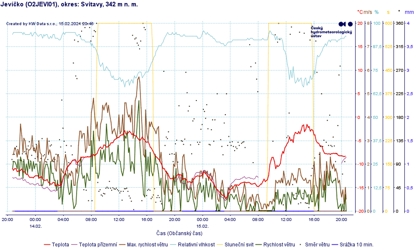Status of transponders 15.2.2021
Today I woke up from hibernation for a while. Behind the windows is a beautiful day with a temperature below freezing. So I remembered the summer experiments with LNB cooling and I thought it would be a shame not to use the outdoor weather. Of course, today's results cannot be directly compared with the table from August 2020, because it is a completely different time of year. Still, I wondered if there had been any major change.
Jevíčko site, Czech Republic, Latitude: 49.6322 °, Longitude: 16.7113 °
LNB 2x NJR2842
Coaxial cable Belden H125 CU, 45m
Receiver VU+ Ultimo4k, VTI
Air temperature -3°C, the sun is shining on the LNB
When comparing the measured data, it can be said very simply that today's values are slightly better than 6.8.2020 in the evening, but slightly worse than 9.8.2020 around noon. This would confirm the assumption that the signal periodically increases during the morning and weakens during the afternoon. Some extreme difference compared to the seasons of summer - winter does not take place. Likewise, the lower ambient air temperature did not bring any big surprises. Perhaps it would be worth mentioning that the Astra 2G generally had somewhat weaker signals today. But this is information for ordinary users who want to watch TV. Not the sight of a signal hunter dealing with every fraction of a decibel.
Data for azimuth and elevation are given in pulses counted by EGIS positioner sensors. For azimuth the conversion is 200 pulses to 1°, for elevation 800 pulses to 1°. I present them for an approximate representation of the different positions of individual satellites. They cannot be directly compared with the values from last summer, because I had problems with the stability of the supporting structure in the period of stronger autumn winds, which I describe at the end of the article in the appendix dated 21.10.2020. So the rotation of the support tube has changed.
The indicated signal strength ranges 0 ÷ xx % mean that the strength fluctuates continuously in this range with a period of several seconds. The signal is, of course, unusable for reception. At least my receiver can't handle it.
To be on the safe side, I would like to emphasize that the measured values of the signal strength are shown by a common satellite receiver, ie not a specialized measuring device. This corresponds to the accuracy of the measurement and the stated values cannot be perceived as absolute. But the signal strength of the individual transponders can be compared with each other. I think the most important information is whether the transponder signal was received or not. And the values given are sufficient for this purpose.
The outside temperature was approximately -3 ° C, but because the sky was clear without a single cloud, the sun shone on both LNBs. It's hard to guess what effect this could have on the internal temperature of the LNB. On the ČHMÚ website, I found an overview of the weather in the place of my location.
The graph seems a bit confusing to me, because it contains a lot of information. Unfortunately, I did not find anything better. It is worth mentioning the temperatures preceding my measurement. They are much lower, so it can be assumed that both LNBs were properly cooled despite the sunlight. I must add that even in the morning at a temperature of -15° C they worked without any problems. Unfortunately, at that time I did not have the opportunity to pay attention to income. And for the next period, warming is already reported. So that's probably all about upcoming in cold winter weather. Good night.





